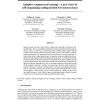11 search results - page 2 / 3 » Acquiring evolvability through adaptive representations |
TVCG
1998
13 years 9 months ago
1998
—Numerical simulation of physical phenomena is now an accepted way of scientific inquiry. However, the field is still evolving, with a profusion of new solution and grid-generati...
ICASSP
2010
IEEE
13 years 10 months ago
2010
IEEE
Sparse coding networks, which utilize unsupervised learning to maximize coding efficiency, have successfully reproduced response properties found in primary visual cortex [1]. Ho...
LWA
2007
13 years 11 months ago
2007
Typical conversational recommender systems support interactive strategies that are hard-coded in advance and followed rigidly during a recommendation session. In fact, Reinforceme...
E4MAS
2005
Springer
14 years 3 months ago
2005
Springer
Abstract. Even if the multi-agent paradigm has been evolving for fifteen years, the development of concrete methods for problem solving remains a major challenge. This paper focus...
VIS
2009
IEEE
14 years 11 months ago
2009
IEEE
Time and streak surfaces are ideal tools to illustrate time-varying vector fields since they directly appeal to the intuition about coherently moving particles. However, efficient ...

